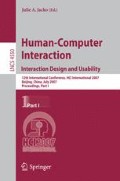Abstract
User-Centeredness is the popular approach for achieving users’ satisfaction. Nevertheless, when considering profit optimization under economy efficiency and the limit of development period, it is almost impossible to apply solutions to all the usability problems reported during the test. Therefore, the strategic approach is required to maximize the perceived usability under the limited circumstance. Physical User Interaction (PUI) is defined as the physical side view of the usability and the broader concept of the usability. In this research, we constructed UI guidelines for PUI (Physical Usability Interaction) of mobile phone reflecting the user’s value. This research applied the Kano’s model of customers’ satisfaction to classify the PUI guidelines into two groups. One is the design standards which must be satisfied to guarantee the minimum satisfaction. The other is the value-adding criteria to hold a dominant position compared to competitive product. From this categorization, we could use the PUI design guidelines not only for evaluating current product quality, but also for finding the direction of strategic value improvement.
Access this chapter
Tax calculation will be finalised at checkout
Purchases are for personal use only
Preview
Unable to display preview. Download preview PDF.
References
Berger, C., Blauth, R., Borger, D., Bolster, C., Burchill, G., DuMouchel, W., Pouliot, F., Richer, R., Rubinoff, A., Shen, D., Timko, M., Walden, D.: Kano’s methods for understanding customer-defined quality. The Center for Quality Management Journal, 2(4) (1993)
Bevan, N.: Quality in use: meeting user needs for quality. Journal of Systems and Software 49(1), 89–96 (1999)
ChiWon, S., JeongYun, H., SangHyun, P.: Evaluating elements of the physical user experience (usability) of mobile device. In: Proceedings of HCI 2006, Korea (2006)
ChiWon, S., JeongYun, H., SangHyun, P.: Classifying emotional elements of Mobile-devices to evaluate physical interface usability. In: Proceedings of Korean Society for Emotion and Sensibility 2006, Korea (2006)
Herzberg, F.: Work and the Nature of Man (1974)
JeongYun, H., SangHyun, P., ChiWon, S.: A Study of Improving Product Usability Based on the Classification of Usability Problems Considering Users’ Satisfaction
Jokela, T.: When Good Things Happen to Bad Products: Where are the Benefits of Usability in the Consumer Appliance Market?”, Ineractions, pp. 29–35 (2004)
Lofgren, M., Witell, L.: Kano’s Theory of Attractive Quality and Packaging, 2005. Quality Management Journal 12(3), 7–20 (2005)
Kano, N., Seraku, N., Takahashi, F., Tsuji, S.: Attractive quality and must-be quality. The Journal of Japaneses Society for Quality Control 14(2), 39–48 (1984)
Matzler, K., Hinterhuber, H.H.: How to make product development projects more successful by integrating Kano’s model of customer satisfaction into quality. Technovation 18(1), 25–38 (1998)
Zhang, P., von Dran, G.M.: Satisfiers and Dissatisfiers: A Two-Factor Model for Website Design and Evaluation. Journal of The American Society For Information Science 51(14), 1253–1268 (2000)
Author information
Authors and Affiliations
Editor information
Rights and permissions
Copyright information
© 2007 Springer-Verlag Berlin Heidelberg
About this paper
Cite this paper
Heo, J., Park, S., Song, C. (2007). A Study on the Improving Product Usability Applying the Kano’s Model of Customer Satisfaction. In: Jacko, J.A. (eds) Human-Computer Interaction. Interaction Design and Usability. HCI 2007. Lecture Notes in Computer Science, vol 4550. Springer, Berlin, Heidelberg. https://doi.org/10.1007/978-3-540-73105-4_53
Download citation
DOI: https://doi.org/10.1007/978-3-540-73105-4_53
Publisher Name: Springer, Berlin, Heidelberg
Print ISBN: 978-3-540-73104-7
Online ISBN: 978-3-540-73105-4
eBook Packages: Computer ScienceComputer Science (R0)

